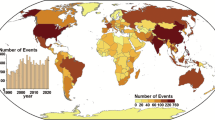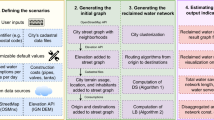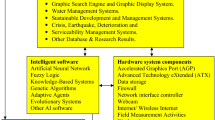Abstract
In many countries, water distribution systems consist of large, highly pressurized pipe networks that require an excessive amount of energy and that are vulnerable to large-scale contamination. To imagine the future of water distribution, we can learn from Hanoi, Vietnam, where water is distributed at low pressures and most buildings are equipped with a basement tank, a rooftop tank, and separate water treatment processes, resulting in a system that consumes less energy and that is more resilient.
Similar content being viewed by others
Collect, treat, distribute, consume. This is more or less what water distribution consists of in many countries. Water is first collected from a natural source and pumped into a water treatment plant, and it is then treated. Subsequently, it is propelled into large networks of pipes that systematically need to be pressurized so that drinkable water flows out whenever we open a tap; see Fig. 1a. Throughout the world, this is often seen as the preferred solution to operate water distribution systems; i.e., the “golden standard”. The problem is that this model is not adapted to tackle the challenges of the twenty-first century and it possesses at least two major problems.
First, ensuring that water pipes are systematically pressurized requires an excessive amount of energy (~80% of all the energy used by water utilities in the United States1). This represents so much energy that water utilities are often the largest clients of electric utilities. Chini and Stillwell2 found that, on average, the treatment and distribution of water in the US requires 340 Wh m−3. Second, water distribution systems are not resilient. Again, because water pipes are constantly under high pressure, enormous forces are exerted on pipe walls, and as water distribution systems get older, the occurrence of pipe breaks is inevitable. Consequently, many water utilities go to great lengths to minimize any subtle change in water pressure to avoid water hammers that can result in pipe breaks and that can lead to large-scale contamination. As water distribution systems are getting older in many cities around the world, it may be time to revisit the golden standard of water distribution.
In the search for a different model, we can learn from Hanoi, the Vietnamese capital; see Fig. 1b. The initial process in Hanoi is similar to the golden standard. Water is collected from a natural source (i.e., surface water bodies or groundwater wells) and it is treated. Water is then pumped into an extensive pipe network. The difference is that until 2008, not enough water could be treated and pumped to supply the entire city, and therefore, one by one, certain sections of cities were shut off from the water distribution systems during the day—these systems are called intermittent water supply (IWS) systems, in contrast to continuous water supply (CWS) systems, and are common in low and middle income countries. As a result, nearly every building had a water tank in the basement to store water when the system was not running—these secondary, in-building systems are called secondary water supply (SWS) systems. While Hanoi is now continuously supplied with water, the practice remains. Consequently, buildings are generally self-sufficient for several days when the water supply is interrupted. As an example, in October 2019, one water treatment plant in Hanoi was contaminated, which in turn contaminated a portion of the water network, but most buildings were not disrupted because they had isolated themselves from the network in a timely manner and they had stored sufficient water for several days. Moreover, because buildings are equipped with basement tanks, water pressure in the system can be lower. In Hanoi, low-pressure zones have pressures around 10 meters (the minimum acceptable for fire safety), thus requiring less energy than the golden standard—as an example, in the US, average water pressure tends to be ~30 meters (roughly to supply a five-story building). More generally, beyond the context of Hanoi, water pressure management is well studied and has been recognized to help reduce leakage and energy consumption3.
In addition, most buildings in Hanoi have another smaller water tank placed on roofs. Water from the basement tank is first pumped to the roof tank—the process is usually automatic but it could be programmed to only run when electricity demand is low. For a typical house, the basement tank has a volume of 3–5 cubic meters while the rooftop tank contains about 1–2 cubic meters of water; see a picture with typical rooftop tanks, Fig. 2. Because the tank is on the roof, gravity alone is used to supply water throughout a building, and water can therefore be supplied during power outages (until the rooftop tank is empty).
Overall, in Hanoi, water distribution consumes about 100 Wh m−3 for treatment and distribution (data from the Hanoi Water Limited Company) and about 130 Wh m−3 to pump water from the basement tank to the roof tank (for a four-story building; see Methods), for a total of 230 Wh m−3 (about two-thirds the US average).
Naturally, the Hanoi model is not without flaws. Large pressure differentials in water distribution systems can degrade water pipes more quickly as is common in IWS systems. Moreover, as a result of allowing lower water pressures or even shutting off the water distribution systems to part of the city (as it used to be), contaminated groundwater may enter the pipe network and contaminate the entire system. To partly tackle water quality issues, in Hanoi, many buildings are further equipped with separate treatment processes, located after the rooftop water tank (i.e., after the SWS system) to treat potable water on demand (often in the form of water filters). This strategy further ensures that water quality is controlled by the user. In fact, once it passes the water meter, water is owned by the property owner. As a result, the owner is responsible for the quality of water once it reaches the SWS system; and, if not maintained well, water quality can be affected in SWS systems due to longer water stagnation times, higher temperatures, and loss of disinfectant residuals4. One consequence of transferring some of the responsibility to building owners is that some financial burden is placed onto building owners themselves.
Overall, Hanoi has achieved a hybrid system that is both centralized and decentralized. The distribution of clear, low-pressurized water is centralized, similar to the golden standard, except that the process tends to consume less energy. Once water enters a building, it is generally stored in a basement tank, then pumped to a smaller rooftop tank, and finally treated one last time into potable water. In contrast to the collect, treat, distribute, consume model, Hanoi follows a collect, treat, distribute, store, treat, consume model. In the end, the Hanoi model is both more resilient while potentially requiring less energy to operate.
Ultimately, the legacy from the end of the nineteenth century of keeping enormous pipe networks pressurized with potable water is simply neither sustainable nor resilient. Water distribution as a whole should be revisited and better integrated with other infrastructure systems5,6,7. Any effort to transform the golden standard will require substantial learning and a dramatic sociotechnical transition, and while the Hanoi model is not perfect, it offers valuable insights and ideas to set us on the path toward the future of water distribution.
Methods
Equation (1) is used to estimate the energy consumption Epump to pump water from a basement to a rooftop tank.
where ρ is the water density (i.e., 1000 kg m−3); g is the gravity acceleration (i.e., 9.81 m s−2); V is the pumped water volume; H is the geodetic lift; hf is the total friction loss (i.e., for indoor pipe network, friction losses are estimated to make up 30% of the geodetic lift); ηpump is the pump’s efficiency (for indoor systems ηpump is ~30–60% depending on pump’s age8); ηmotor is the pump motor’s efficiency (for small motors, with rated power under 2.2 kW, ηmotor is ~75%).
For a typical four-story residential house (H = 14 m), assuming a pump efficiency of 50%, the energy consumption to pump 1 m3 of water from the basement to the roof is \(E_{{\mathrm{pump}}} = \frac{{1,000 \times 9.81 \times 1 \times 1.3 \times 14}}{{0.5 \times 0.75 \times 3600}} = 132.25\) Wh, thus ~130 Wh.
Reporting summary
Further information on research design is available in the Nature Research Reporting Summary linked to this article.
Data availability
No datasets were generated or analyzed during the current study. One data point was collected from the Hanoi Water Limited Company (http://hawacom.vn/home/), as described in the following figshare metadata record9: https://doi.org/10.6084/m9.figshare.13160015.
References
Sedlak, D. L. Water 4.0: The Past, Present, and Future of the World’s Most Vital Resource (Yale University Press, New Haven, 2014).
Chini, C. M. & Stillwell, A. S. The state of U.S. urban water: data and the energy–water nexus. Water Resour. Res. 54, 1796–1811 (2018).
Vicente, D. J., Garrote, L., Sánchez, R. & Santillán, D. Pressure management in water distribution systems: current status, proposals, and future trends. J. Water Resour. Plan. Manag. 142, 04015061 (2016).
Li, H. et al. Influence of secondary water supply systems on microbial community structure and opportunistic pathogen gene markers. Water Res. 136, 160–168 (2018).
Derrible, S. Urban infrastructure is not a tree: integrating and decentralizing urban infrastructure systems. Environ. Plan. B 44, 553–569 (2016).
Derrible, S. An approach to designing sustainable urban infrastructure. MRS Energy Sustain. 5, E15 (2019).
Derrible, S. Urban Engineering for Sustainability (MIT Press, Cambridge, 2019).
Wong, L. T., Mui, K. W., Lau, C. P. & Zhou, Y. Pump efficiency of water supply systems in buildings of Hong Kong. Energy Procedia 61, 335–338 (2014).
Derrible, S., Truong, T., Pham, H. & Nguyen, Q. Metadata Supporting the Article: Learning from Hanoi to Imagine the Future of Water Distribution. figshare https://doi.org/10.6084/m9.figshare.13160015 (2020). Accessed 1 Jan 2021.
Acknowledgements
This work was supported in part by the United States National Science Foundation (NSF) under Grant No. 1551731. The authors would also like to thank Professor Mikhail Chester for providing relevant comments.
Author information
Authors and Affiliations
Contributions
S.D. conceived the idea for the work. T.T.M.T. collected information and data from the Hanoi Water Limited Company. P.T.H. performed the analysis and analyzed the results. N.H.Q. interpreted the results and contributed to the idea and discussion. S.D. led the writing of the manuscript with major inputs from all authors.
Corresponding author
Ethics declarations
Competing interests
The authors declare no competing interests.
Additional information
Publisher’s note Springer Nature remains neutral with regard to jurisdictional claims in published maps and institutional affiliations.
Supplementary information
Rights and permissions
Open Access This article is licensed under a Creative Commons Attribution 4.0 International License, which permits use, sharing, adaptation, distribution and reproduction in any medium or format, as long as you give appropriate credit to the original author(s) and the source, provide a link to the Creative Commons license, and indicate if changes were made. The images or other third party material in this article are included in the article’s Creative Commons license, unless indicated otherwise in a credit line to the material. If material is not included in the article’s Creative Commons license and your intended use is not permitted by statutory regulation or exceeds the permitted use, you will need to obtain permission directly from the copyright holder. To view a copy of this license, visit http://creativecommons.org/licenses/by/4.0/.
About this article
Cite this article
Derrible, S., Truong, T.T.M., Pham, H.T. et al. Learning from Hanoi to imagine the future of water distribution. npj Urban Sustain 1, 9 (2021). https://doi.org/10.1038/s42949-020-00001-x
Received:
Accepted:
Published:
DOI: https://doi.org/10.1038/s42949-020-00001-x
This article is cited by
-
Urbanization in the Anthropocene: inaugural npj Urban Sustainability
npj Urban Sustainability (2021)





